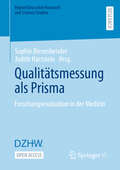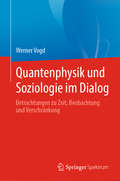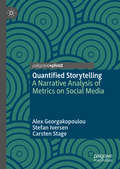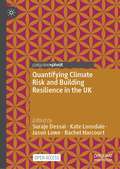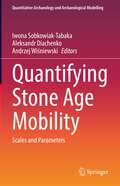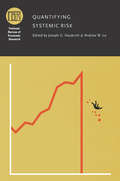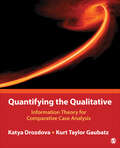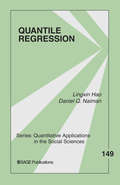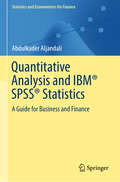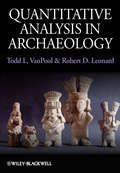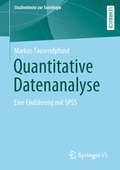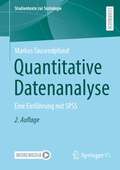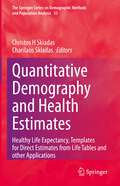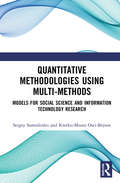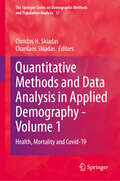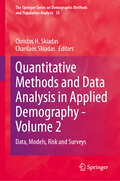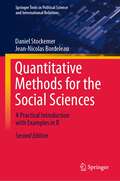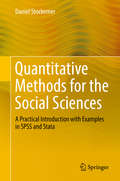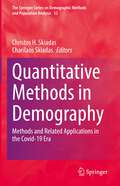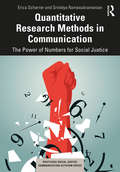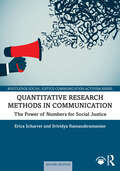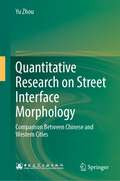- Table View
- List View
Qualität in der Deradikalisierungsarbeit: Dimensionen – Potenziale – Desiderata (essentials)
by Michail LogvinovDieses essential behandelt Potenziale und Handlungsbedarfe der Qualitätsförderung in der Deradikalisierungsarbeit. Durch die Benennung einzelner Qualitätsdimensionen und -kriterien wird ein praxisorientierter Beitrag zu den kontrovers diskutierten Themen Qualität, Wirkung und Effektivität von Maßnahmen geleistet. Als Vergleichsgrundlage fungieren dabei die Qualitätsdebatte in der Sozialen Arbeit, englischsprachige Forschungen zur Effektivität und Leistungsfähigkeit von Non-Profit-Organisationen, die Qualitätssicherung in der Kriminalprävention und die evidenzorientierte Erforschung der Umsetzungsqualität von Resozialisierungsprogrammen. Im Ergebnis wird eine Reihe von Ansätzen, Standards, Indikatoren und Prädiktoren diskutiert, die für die interne Qualitätsentwicklung der Fachpraxis einen Mehrwert ergeben.
Qualitätsmessung als Prisma: Forschungsevaluation in der Medizin (Higher Education Research and Science Studies)
by Sophie Biesenbender Judith HartsteinIn diesem Open-Access-Sammelband werden verschiedene Leistungsdimensionen und Datenzugänge für Abbildung medizinischer Forschung empirisch dargestellt und diskutiert. Leitfragen sind dabei:Wie identifizieren wir Qualität in der medizinischen Forschung?Unter welchen Bedingungen lassen sich medizinische Themen bestmöglich beforschen, um das Patientenwohl und die öffentliche Gesundheit zu fördern sowie Wissenschaft und Gesellschaft voranzubringen?Dieser Logik folgend startet der Sammelband mit Überblicksdarstellungen zum Stand der Evaluation medizinischer Forschung in Deutschland, führt dann auf die eher methodischen, informationswissenschaftlichen Aspekte und empirischen Perspektiven auf die Evaluation medizinischer Forschung und ergänzt diese mit soziologischen Aspekten zur Evaluation medizinischer Forschung als Steuerungsinstrument.
Quantenphysik und Soziologie im Dialog: Betrachtungen zu Zeit, Beobachtung und Verschränkung
by Werner VogdSei es in der Quantenphysik, den Kognitionswissenschaften oder der Soziologie – die Problematik des Beobachters und die Einbeziehung von Nicht-Wissen und Unbestimmtheiten ist in verschiedenen wissenschaftlichen Feldern nicht zuletzt aus empirischen Gründen entstanden. Die hiermit verbundenen theoretischen Konzepte bringen nolens volens Aporien oder Paradoxien mit sich. Nicht zuletzt aus diesem Grunde verspricht der Vergleich von Quantenphysik und Soziologie neue Einsichten in die Leistungen wie auch Probleme von Weltbeschreibungen, die Selbstreferenz nicht per se ausschließen möchten. Der Dialog geschieht anhand ausgewählter Problemfelder. Zu nennen sind hier etwa:Der Objekt-Subjekt-Schnitt;die Frage, was (für wen) Information ist, die Beobachterabhängigkeit von Begriffen wie Probabilität, Kausalität und Unbestimmtheit, die Modellierung extrinsischer Eigenschaften, der Umgang mit Komplexität sowie das Verhältnis von Sinn, Gegenstand und Interpretation. Mit Blick auf die Arbeiten aus dem Umfeld von Anton Zeilinger treten in diesem Projekt renommierte Physiker und Soziologen in einen Dialog, der neben erkenntnistheoretischen Problemen nicht zuletzt auch die offenen Fragen des eigenen Fachgebiets behandelt.
Quantified Storytelling: A Narrative Analysis of Metrics on Social Media
by Carsten Stage Alex Georgakopoulou Stefan IversenThis book interrogates the role of quantification in stories on social media: how do visible numbers (e.g. of views, shares, likes) and invisible algorithmic measurements shape the stories we post and engage with? The links of quantification with stories have not been explored sufficiently in storytelling research or in social media studies, despite the fact that platforms have been integrating sophisticated metrics into developing facilities for sharing stories, with a massive appeal to ordinary users, influencers and businesses alike. With case-studies from Instagram, Reddit and Snapchat, the authors show how three types of metrics, namely content metrics, interface metrics and algorithmic metrics, affect the ways in which cancer patients share their experiences, the circulation of specific stories that mobilize counter-publics and the design of stories as facilities on platforms. The analyses document how numbers structure elements in stories, indicate and produce engagement and become resources for the tellers’ self-presentation. This book will be of interest to students and scholars working in the fields of narrative and social media studies, including narratology, biography studies, digital storytelling, life-writing, narrative psychology, sociological approaches to narrative, discourse and sociolinguistic perspectives.
Quantifying Climate Risk and Building Resilience in the UK
by Jason Lowe Suraje Dessai Kate Lonsdale Rachel HarcourtThis open access book draws together key research from the UK Climate Resilience programme. It focuses on topics central to the programme’s research agenda, including improved characterisation and quantification of climate risks, enhanced understanding of the management of climate risks, and the development and delivery of climate services. Key chapters address the challenges inherent to undertaking resilience research, including how to make the term ‘climate resilience’ usable and useful, co-producing research between academics, policy makers and practitioners, and engaging and communicating outside of academia. This book is unique in providing a concise and accessible overview of the programme’s key lessons, placing the findings into a wider context and it will inform future research, policy and practice agendas.
Quantifying Stone Age Mobility: Scales and Parameters (Quantitative Archaeology and Archaeological Modelling)
by Iwona Sobkowiak-Tabaka Aleksandr Diachenko Andrzej WiśniewskiThis book focuses on the analysis of different scales of mobility and addresses parameters and proxies of population movement aiming at the formation of a ‘ground’ for the further development of quantitative approaches. In order to do so, the volume explores wide scale mobility (environmental contexts and cross-cultural trends), seasonal mobility of Paleolithic and Mesolithic hunter-gatherers, and migration, niche construction, utilitarian and non- utilitarian factors of mobility.Chapters in the volume include case studies from across Europe and Asia. The editors’ introduction addresses the current state of mobility discourse in archaeology. The chapters address questions related to parameters used to describe different factors of movement and examines correlations between parameters describing environmental diversity, demography, and the values representing spatial movement. This volume is of interest to students and researchers of mobility of human beings in the past.
Quantifying Systemic Risk (National Bureau of Economic Research Conference Report)
by Andrew W. Lo Joseph G. HaubrichIn the aftermath of the recent financial crisis, the federal government has pursued significant regulatory reforms, including proposals to measure and monitor systemic risk. However, there is much debate about how this might be accomplished quantitatively and objectivelyOCoor whether this is even possible. A key issue is determining the appropriate trade-offs between risk and reward from a policy and social welfare perspective given the potential negative impact of crises. aOne of the first books to address the challenges of measuring statistical risk from a system-wide persepective, " Quantifying Systemic Risk "looks at the means of measuring systemic risk and explores alternative approaches. Among the topics discussed are the challenges of tying regulations to specific quantitative measures, the effects of learning and adaptation on the evolution of the market, and the distinction between the shocks that start a crisis and the mechanisms that enable it to grow.
Quantifying the Qualitative: Information Theory for Comparative Case Analysis
by Kurt Taylor Gaubatz Dr Ekaterina DrozdovaQuantifying the Qualitative by Katya Drozdova and Kurt Taylor Gaubatz presents a systematic approach to comparative case analysis based on insights from information theory. This new method, which requires minimal quantitative skills, helps students, policymakers, professionals, and scholars learn more from comparative cases. The approach avoids the limitations of traditional statistics in the small-n context and allows analysts to systematically assess and compare the impact of a set of factors on case outcomes with easy-to-use analytics. Rigorous tools reduce bias, improve the knowledge gained from case studies, and provide straightforward metrics for effectively communicating results to a range of readers and leaders.
Quantifying the Qualitative: Information Theory for Comparative Case Analysis
by Kurt Taylor Gaubatz Dr Ekaterina DrozdovaQuantifying the Qualitative by Katya Drozdova and Kurt Taylor Gaubatz presents a systematic approach to comparative case analysis based on insights from information theory. This new method, which requires minimal quantitative skills, helps students, policymakers, professionals, and scholars learn more from comparative cases. The approach avoids the limitations of traditional statistics in the small-n context and allows analysts to systematically assess and compare the impact of a set of factors on case outcomes with easy-to-use analytics. Rigorous tools reduce bias, improve the knowledge gained from case studies, and provide straightforward metrics for effectively communicating results to a range of readers and leaders.
Quantile Regression
by Lingxin Hao Daniel Q. NaimanQuantile Regression, the first book of Hao and Naiman's two-book series, establishes the seldom recognized link between inequality studies and quantile regression models. Though separate methodological literature exists for each subject, the authors seek to explore the natural connections between this increasingly sought-after tool and research topics in the social sciences. Quantile regression as a method does not rely on assumptions as restrictive as those for the classical linear regression; though more traditional models such as least squares linear regression are more widely utilized, Hao and Naiman show, in their application of quantile regression to empirical research, how this model yields a more complete understanding of inequality. Inequality is a perennial concern in the social sciences, and recently there has been much research in health inequality as well. Major software packages have also gradually implemented quantile regression. Quantile Regression will be of interest not only to the traditional social science market but other markets such as the health and public health related disciplines.Key Features:Establishes a natural link between quantile regression and inequality studies in the social sciences Contains clearly defined terms, simplified empirical equations, illustrative graphs, empirical tables and graphs from examples Includes computational codes using statistical software popular among social scientists Oriented to empirical research
Quantitative Analysis and IBM® SPSS® Statistics
by Abdulkader AljandaliThis guide for practicing statisticians and data scientists who use IBM SPSS for statistical analysis of big data in business and finance is the first of a two-part guide to SPSS for Windows, introducing data entry into SPSS, along with elementary statistical and graphical methods for summarizing and presenting data. Part I also covers the rudiments of hypothesis testing and business forecasting while Part II will present multivariate statistical methods, more advanced forecasting methods, and multivariate methods. IBM SPSS offers a powerful set of statistical and information analysis systems that run on a wide variety of personal computers. The Windows version of SPSS is built around routines that have been developed, tested, and widely used for more than 20 years. As such, SPSS is extensively used in industry, commerce, banking, local and national governments, and education. Just a small subset of users of the package include the major clearing banks, the BBC, British Gas, British Airways, British Telecom, the Consumer Association, Eurotunnel, Glaxo, ICI, London Underground, the NHS, Plessey, Shell, Unilever, and W. H. Smith and Son. Although the emphasis in this guide is on applications of SPSS for Windows, there is a need for users to be aware of the statistical assumptions and rationales underpinning correct and meaningful application of the techniques available in the packa≥ therefore, such assumptions are discussed, and methods of assessing their validity are described. Also presented is the logic underlying the computation of the more commonly used test statistics in the area of hypothesis testing. Mathematical background is kept to a minimum.
Quantitative Analysis in Archaeology
by Robert D. Leonard Todd L. VanPoolQuantitative Analysis in Archaeology introduces the application of quantitative methods in archaeology. It outlines conceptual and statistical principles, illustrates their application, and provides problem sets for practice. Discusses both methodological frameworks and quantitative methods of archaeological analysis Presents statistical material in a clear and straightforward manner ideal for students and professionals in the field Includes illustrative problem sets and practice exercises in each chapter that reinforce practical application of quantitative analysis
Quantitative Datenanalyse: Eine Einführung mit SPSS (Studientexte zur Soziologie)
by Markus TausendpfundDas Buch bietet eine Einführung in die quantitative Datenanalyse mit dem Statistikprogramm SPSS. Es werden Kenntnisse vermittelt, um einfache Analysen selbstständig durchführen zu können. Dazu gehören der Download von Sekundärdatensätzen, die sachgemäße Kodierung von Variablen (Datenaufbereitung), die uni- und bivariate Datenanalyse sowie multivariate Analyseverfahren. Für eine möglichst praxisnahe Darstellung werden die einzelnen Analysen auf Basis der ALLBUS-Daten 2014 illustriert. Dabei werden die zentralen Befehle (Syntax) vorgestellt, die für die Datenanalyse mit SPSS erforderlich sind.
Quantitative Datenanalyse: Eine Einführung mit SPSS (Studientexte zur Soziologie)
by Markus TausendpfundDas Buch bietet eine Einführung in die quantitative Datenanalyse mit dem Statistikprogramm SPSS. Es werden Kenntnisse vermittelt, um einfache Analysen selbstständig durchführen zu können. Dazu gehören der Download von Sekundärdatensätzen, die sachgemäße Kodierung von Variablen (Datenaufbereitung), die uni- und bivariate Datenanalyse sowie multivariate Analyseverfahren. Für eine möglichst praxisnahe Darstellung werden die einzelnen Analysen auf Basis der ALLBUS-Daten 2018 illustriert. Dabei werden die zentralen Befehle (Syntax) vorgestellt, die für die Datenanalyse mit SPSS erforderlich sind.
Quantitative Demography and Health Estimates: Healthy Life Expectancy, Templates for Direct Estimates from Life Tables and other Applications (The Springer Series on Demographic Methods and Population Analysis #55)
by Charilaos Skiadas Christos H SkiadasThis book provides new theoretic and applied material with focus on quantitative methods and data analysis techniques applied in demography, population studies, health issues and statistics. It discusses the quantitative techniques to estimate the healthy life expectancy by expanding the classical life tables to include the proportion with disability calculated from life tables, along with the Sullivan method. The provided templates apply immediately to the life tables from WHO, HMD, Eurostat and other life table providers. Furthermore, the book explores the possibility of creating new health indicators along with Covid-19 pandemic management, factors associated to loneliness and an alcohol indicator. Part of the book is devoted to mortality, epidemic models, and the supercentenarians age estimation. Data analysis and artificial intelligence methods are included to apply in demographic and socio-economic cases. By providing a methodology to cope with health problems in demography and society by quantifying important health parameters, this book is a valuable guide for researchers, theoreticians, and practitioners from various disciplines and especially health scientists, statisticians, economists, and sociologists.
Quantitative Methodologies using Multi-Methods: Models for Social Science and Information Technology Research
by Kweku-Muata Osei-Bryson Sergey SamoilenkoQuantitative Methodologies using Multi-Methods is a multifaceted book written to help researchers. It is a user-friendly introduction to the popular methods of data mining and data analysis. The book avoids getting involved into details that are more suitable for more advanced users; it is written for readers who have, at most, a surface-level knowledge of the methods presented in the book. The book also serves as an introductory guide to the subject of complementarity of the tools and techniques of data analysis. It shows how methods could be used in synergy to offer insights into the issues that could not be dissected by any single method alone. This text can also be used as a set of templates, where, given a set of research questions, the investigator could identify a set of methodological modules allowing for answering the research questions of interest. This is not entirely unlike the relationship between analysis and design phases of the systems development life cycle — where the "What?" of the analysis phase has to be translated into the "How" of the design phase. The book can guide the identification of modules (the "How") that are suitable for answering research questions (the "What"). It can aid in transitioning a conceptual domain of the research questions into a scaffolding of data analytic and data mining methods. The book is also a guide to exploring what data under investigation holds. For example, an investigator may use the methodological modules presented in this book to generate a set of preliminary questions which, after a careful consideration and a requisite culling, could be formulated into a set of questions consistent within a selected theory or a framework. Finally, the book can be used as a generator of new research questions. Applying every method in each of the book’s modules opens a new dimension ripe with follow-up questions such as, "Why is this so?" The answers to this question may provide new insight and lead to the development of a new theory.
Quantitative Methods and Data Analysis in Applied Demography - Volume 1: Health, Mortality and Covid-19 (The Springer Series on Demographic Methods and Population Analysis #57)
by Christos H. Skiadas Charilaos SkiadasThis first volume of two provides quantitative techniques to estimate the healthy life years lost by expanding the classical life tables to include the proportion with disability calculated from life tables, along with a final part using the Sullivan method. The provided templates apply immediately to the life tables from the WHO, HMD, Eurostat and other life table providers. Furthermore, the possibility of creating new health indicators is explored along with Covid-19 pandemic management. A part of this book is devoted to mortality, epidemic models, and comparative studies in Czehia, Greece, and the EU. Data analysis and artificial intelligence methods are included to apply in demographic and Cox regression and gender differences and the gender gap in EU. Mortality is tested with support methodology, while the gender gap is extensively analyzed and tested in several countries. The post covid-19 cases are tested, including mortality and economic implications for cases from China, Greece and Czechia. The stochastic behavior of Epstein-Barr Virus is explored and a case study on heterochronous Maltese SARS-CoV-2 genomic data is presented. Leonhard Euler’s research on the multiplication of the human race with models of population growth is also reviewed. By providing a methodology to cope with health and mortality problems in demography and society in Volume 1 and quantifying important health parameters in Volume 2, the books are a valuable guide for researchers, theoreticians, and practitioners from various disciplines and especially applied demographers, health scientists, statisticians, economists, and sociologists.
Quantitative Methods and Data Analysis in Applied Demography - Volume 2: Data, Models, Risk and Surveys (The Springer Series on Demographic Methods and Population Analysis #58)
by Christos H. Skiadas Charilaos SkiadasThis second volume of two complements volume 1 by discussing models, risk and surveys in applied demography. Models and modeling cover a wide range of data analysis methods and techniques to cope with demographic data including principal components, clustering, GARCH models and dynamic correlation, multilevel models and stochastic insurance models including an R package for clustering as well. Surveys cope with the analysis of various data set arising in National and International context. Data from European Social Survey and National surveys are analyzed, as well as food waste generation analysis and social mobility in Europe along with post Covid-19 data sets. By providing a methodology to cope with health and mortality problems in demography and society in Volume 1 and quantifying important health parameters in Volume 2, the books are a valuable guide for applied demographers, researchers, theoreticians, and practitioners from various disciplines and especiallyhealth scientists, statisticians, economists, and sociologists.
Quantitative Methods for the Social Sciences: A Practical Introduction with Examples in R (Springer Texts in Political Science and International Relations)
by Daniel Stockemer Jean-Nicolas BordeleauThis textbook offers an essential introduction to survey research and quantitative methods with clear instructions on how to conduct statistical tests with R. Building on the premise that we need to teach statistical methods in a holistic and practical format, the book guides students through the four main elements of survey research and quantitative analysis: (1) the importance of survey research, (2) preparing a survey, (3) conducting a survey and (4) analyzing a survey. In detail, students will learn how to create their own questionnaire on the basis of formulating hypotheses; sampling participants; disseminating their questionnaire; creating datasets; and analyzing their data. The data analytical sections of this revised and extended edition explain the theory, rationale and mathematical foundations of relevant bivariate and multi-variate statistical tests. These include the T-test, F-test, Chi-square test and correlation analyses, as well as bivariate and multivariate regression analyses. In addition, the book offers a brief introduction to statistical computing with R, which includes clear instructions on how to conduct these statistical tests in R. Given the breadth of its coverage, the textbook is suitable for introductory statistics, survey research and quantitative methods classes in the social sciences.
Quantitative Methods for the Social Sciences: A Practical Introduction with Examples in SPSS and Stata
by Daniel StockemerThis textbook offers an essential introduction to survey research and quantitative methods. Building on the premise that statistical methods need to be learned in a practical fashion, the book guides students through the various steps of the survey research process and helps to apply those steps toward a real example. In detail, the textbook introduces students to the four pillars of survey research and quantitative analysis: (1) the importance of survey research, (2) preparing a survey, (3) conducting a survey and (4) analyzing a survey. Students are shown how to create their own questionnaire based on some theoretically derived hypotheses to achieve empirical findings for a solid dataset. Lastly, they use said data to test their hypotheses in a bivariate and multivariate realm. The book explains the theory, rationale and mathematical foundations of these tests. In addition, it provides clear instructions on how to conduct the tests in SPSS and Stata. Given the breadth of its coverage, the textbook is suitable for introductory statistics, survey research or quantitative methods classes in the social sciences.
Quantitative Methods in Demography: Methods and Related Applications in the Covid-19 Era (The Springer Series on Demographic Methods and Population Analysis #52)
by Christos H. Skiadas Charilaos SkiadasThis book provides quantitative and applied methodologies in the Covid-19 era exploring important issues in demography, population studies, and health. It provides insight into health and health measures as to the healthy life years lost and the healthy life expectancy related to Covid-19 pandemic. It also describes mortality and survival and focuses on data analysis in demography and population studies. Special methods and applications in demography and society are also described, thereby including applications in society, pension and insurance. As such, this book is a valuable guide for researchers, theoreticians and practitioners from various scientific fields.
Quantitative Methods in Tourism Economics
by Peter Nijkamp Manuela Sarmento Álvaro MatiasTourism economics is partly based on established principles from the economics discipline, but it also incorporates elements from sociology, psychology, organization theory and ecology. It has over the years turned into an appealing multi-disciplinary oriented approach to the understanding of the impacts of leisure time in a modern society, including cultural heritage, sustainable quality of life, and industrial organization of the hospitality industry. The increasing dynamics in the tourist industry and its worldwide effects will continue to attract the attention of both the research and the policy sector in the years to come. Rather than speculating on non-observed facts, there is a clear need for evidence-based research in order to map out the complex dynamics of the tourist industry. The present volume comprises novel studies - mainly of a quantitative-analytical nature - on the supply, demand and contextual aspects of modern tourism. It contains a sound mix of theory, methodology, policy and case studies on various tourism issues in different parts of the world.
Quantitative Research Methods in Communication: The Power of Numbers for Social Justice (Routledge Social Justice Communication Activism Series)
by Erica Scharrer Srividya RamasubramanianThis textbook is an advanced introduction to quantitative methods for students in communication and allied social science disciplines that focuses on why and how to conduct research that contributes to social justice. Today’s researchers are inspired by the potential for scholarship to make a difference for society, to push toward more just and equitable ends, and to engage in dialogue with members of the public so that they can make decisions about how to navigate the social, cultural, and political world equipped with accurate, fair, and up-to-date knowledge. This book illustrates the mechanics and the meaning behind quantitative research methods by illustrating each step in the research design process with research addressing questions of social justice. It provides practical guidance for researchers who wish to engage in the transformation of structures, practices, and understandings in society through community and civic engagement and policy formation. It contains step-by-step guidance in quantitative methods—from conceptualization through all the stages of execution of a study, including providing a detailed guide for statistical analysis—and demonstrates how researchers can engage with social justice issues in systematic, rigorous, ethical, and meaningful ways. This text serves as a core or supplementary textbook for graduate and advanced undergraduate courses in research methods for communication and social sciences and fills a gap for a methods text that is responsive to the desire of scholars to conduct socially impactful research.
Quantitative Research Methods in Communication: The Power of Numbers for Social Justice (Routledge Social Justice Communication Activism Series)
by Erica Scharrer Srividya RamasubramanianThis fully updated second edition offers an advanced introduction to quantitative methods that focuses on why and how to conduct research that contributes to social justice.Providing both inspiration and step-by-step guidance on how to conceive, design, and carry out a quantitative study, the book shows how research can be used to work toward a more just and equitable world. The authors provide a detailed guide to quantitative methods and statistical analysis, showing how researchers can engage with social justice issues in systematic, rigorous, ethical, and meaningful ways. This new edition includes a new chapter on writing literature reviews and better aligns with the stages of quantitative research as well as the changing technologies that are available for researchers to both study and use in their work. It includes updated real-world case studies, interviews with scholar-activists, and definitions of key concepts as well as a deeper focus on ethics, social media, computational social sciences, data analytics, and data visualization techniques.Attuned to questions of access, equity, justice, diversity, and inclusion, this textbook is ideal for graduate and advanced undergraduate courses in research methods for communication and the social sciences. It will also be of interest to researchers who wish to engage with the transformation of structures, practices, and understandings in society through community and civic engagement and policy formation.Online resources for instructors include a test bank, PowerPoint slides, sample dataset, and YouTube tutorials. They are available online at www.routledge.com/9781032599878.
Quantitative Research on Street Interface Morphology: Comparison Between Chinese and Western Cities
by Yu ZhouThis book investigates the historical evolution, regional differences, and quantitative measurement on street interface, which forms the street space and plays a very important role in urban form. Empirical research reveals the street interface in Chinese cities are much more complicated than European and American cities. This book explores the reason and reveals the relationship between street interface and urban form in morphology. By constructing quantitative measurement method on street interface morphology, quantitative parameters can be used in urban planning guidelines in China. Both researchers and students working in architecture, urban design, urban planning and urban studies can benefit from this book.

